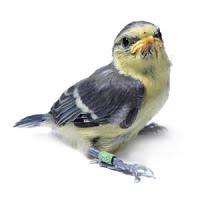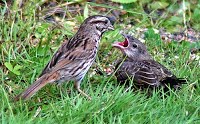BABY SONGBIRD(S)

Staying with their biological parent is their best chance of survival.

1. OBSERVE
Is it a Fledgling | Can’t Fly?

If the bird is almost full-sized, fully feathered, but has short or seemingly no tail feathers, that is a fledgeling who left the nest before being able to fly. Fledglings tend to hop around but not fly. This is normal. The bird may spend many days on the ground being fed by the parents.

Did mom and/or dad come back?
Monitor from a distance to see whether the parents return. Watch carefully with eyes glued to the baby bird for a half to full hour, because the parents can swoop in quickly and secretly, and be missed by the observer. Another way to determine whether the parents are nearby is to check for whitish/gray-colored feces on the ground around the fledgling. This is sign that the parents are feeding him/her, since baby birds defecate after being fed.
What if a dead adult bird is found?
Why not put the baby back in the nest?
The sole purpose of a nest is to hold baby birds while their legs develop. Once the legs are developed and able to stand, the baby bird has no use or reason to stay in the nest. Fledglings are very vulnerable at this stage, so it is essential to keep all pets indoors during this period, especially cats. People wrongly assume that fledgelings are abandoned because they are not flying yet, leading to many unnecessarily “kidnapped” young birds. Some fledgelings fly right out of the nest, others need to spend time on the ground learning to fly. Do not put a fledgeling back in the nest, or in a substitute nest, because the bird will pop right back out!

2. REUNITE
Is it a Nestling | Developing Feathers?

Bird parents build nests for their babies while they grow feathers and gain the strength to perch. Nestlings may be naked, have downy or pin-like feathers, or have patches of regular feathers. They do not hop around, they stay where they have fallen and are in danger (can’t get away).
Fallen from the nest?
With nestlings, the best thing to do is to place the baby birds back in the nest, if safe to do so. It is a myth that the parents will abandon baby birds after they have been touched. Birds have a limited sense of smell, and they too want their young back, just like other animals. Nestlings need the body heat of their siblings and parents to stay alive.
What if the nest is destroyed?
If the original nest is unreachable or destroyed, and the bird in need of help is an older nestling, (almost fully feathered and able to maintain his/her own body heat), secure a wicker basket (available at garden stores, supermarkets, dollar stores, or around the house), close to where the original nest was located. Wicker and other stick-like baskets resemble natural nests and prevent the birds’ legs from becoming splayed while also allowing rain to pass through so the birds do not drown. DO NOT USE MARGARINE TUBS, because they cause the birds legs to develop abnormally and allow for too much pooling of rainwater, which can result in a wet or drowned bird! Make sure the basket is not more than a few inches deep because the parents will not jump into something if they are unable to see out of it. Make sure the substitute nest is not so shallow that the babies will fall out.
Do not relocate the nest!
Parent birds do not have much searching ability; they will continue to go back to where their original nest was to find their babies. If the babies are moved, they usually do not find them. Every substitute nest must be put exactly where the original nest was or extremely close to it.
Do mom and/or dad come back?
Observe from a distance for at least an hour to ensure that the parent(s) return to feed their chicks. Bird parents can be very secretive, so a good observer will glue their eyes to the substitute nest. Just because the parents are not seen returning, does not mean they are not doing so.

3. Call
- Nestling Not Returned To A Nest
- Sick, Cold or Injured
- Dead Parent Found
- Parent Has Not Returned In Hours
While you wait:
If the baby bird is cold, warm the bird by holding him/her in clasped hands (wash hands thoroughly afterwards). Place the baby into a small round container (like a margarine tub), lined with toilet paper so it is very nest-like. Put the “nest” in an aerated small cardboard box (do not use bird cages since feathers can get broken in them). Be sure to provide a heat source (a hand warmer inside a sock, a heating pad on low, under the cardboard box, or an overhead lamp placed directly over the box), to keep the baby warm until help is found.
